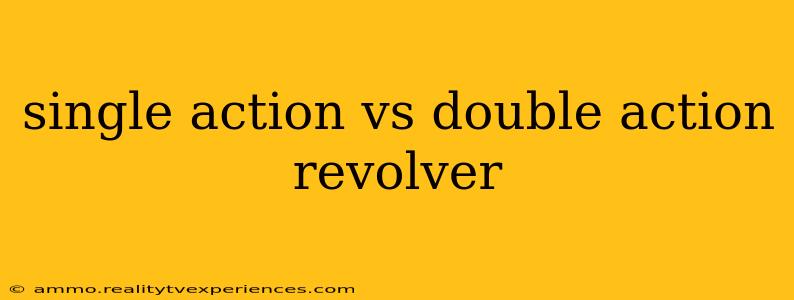Choosing between a single-action and a double-action revolver is a crucial decision for any firearm enthusiast, whether you're a seasoned shooter or a newcomer. Understanding the key differences between these mechanisms is vital for selecting the right tool for your needs, be it self-defense, target shooting, or collecting. This guide will delve into the intricacies of each action type, exploring their pros and cons to help you make an informed choice.
Understanding the Action: Single Action vs. Double Action
The core difference lies in how the hammer is cocked and the firearm is fired. Let's break down each mechanism:
Single Action Revolvers
In a single-action revolver, the hammer must be manually cocked before each shot. This cocking action simultaneously rotates the cylinder to align the next chamber with the barrel. The trigger then simply releases the hammer, firing the cartridge.
Pros of Single Action Revolvers:
- Precise Trigger Pull: Single-action revolvers are renowned for their crisp, light trigger pulls, making them highly accurate, especially for target shooting.
- Simplicity: Their straightforward mechanism leads to fewer potential malfunctions.
- Smooth Operation: The deliberate cocking process contributes to a smooth, controlled firing experience.
- Historical Significance: Many iconic single-action revolvers hold historical and cultural significance, appealing to collectors and enthusiasts alike.
Cons of Single Action Revolvers:
- Slower Rate of Fire: The manual cocking process significantly slows down the rate of fire compared to double-action revolvers.
- Less Suitable for Self-Defense: The slower draw and firing sequence can be a disadvantage in self-defense situations.
- Requires Training: Mastering the manual cocking and precise trigger control requires practice and training.
Double Action Revolvers
Double-action revolvers allow for both cocking the hammer and firing the gun with a single, long trigger pull. The initial portion of the trigger pull cocks the hammer, while the final portion releases it, firing the cartridge.
Pros of Double Action Revolvers:
- Faster Rate of Fire: The ability to fire without manually cocking the hammer allows for a much quicker rate of fire.
- Suitable for Self-Defense: The faster draw and firing sequence make them more suitable for self-defense applications.
- Ease of Use: The simpler operation requires less training and is more intuitive for beginners.
Cons of Double Action Revolvers:
- Heavier Trigger Pull: The long, heavier trigger pull can impact accuracy, especially for those unaccustomed to it.
- More Complex Mechanism: The more complex mechanism can potentially lead to more malfunctions, although modern designs have greatly minimized this risk.
- Less Precise Trigger: The trigger pull is less crisp and precise compared to single-action revolvers.
Choosing the Right Revolver: Factors to Consider
The best type of revolver for you depends on your intended use:
- Target Shooting: Single-action revolvers are generally preferred for their accuracy and light trigger pull.
- Self-Defense: Double-action revolvers offer a faster rate of fire and simpler operation, making them more suitable for self-defense.
- Concealed Carry: Compact double-action revolvers are a popular choice for concealed carry due to their ease of use and quick firing capabilities.
- Collection: The choice often depends on personal preference and the specific revolver's historical or cultural significance.
Ultimately, handling both types of revolvers and understanding your shooting style is essential for making the right decision. Consider visiting a reputable firearms dealer to try out different models and receive expert advice. Remember always to prioritize safety and follow all applicable laws and regulations regarding firearms ownership and use.

